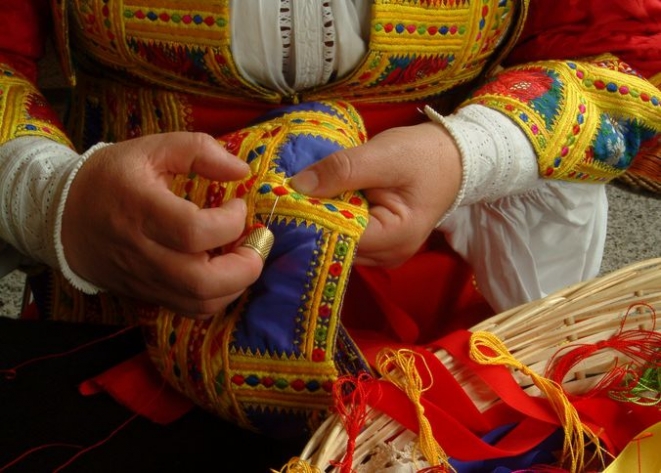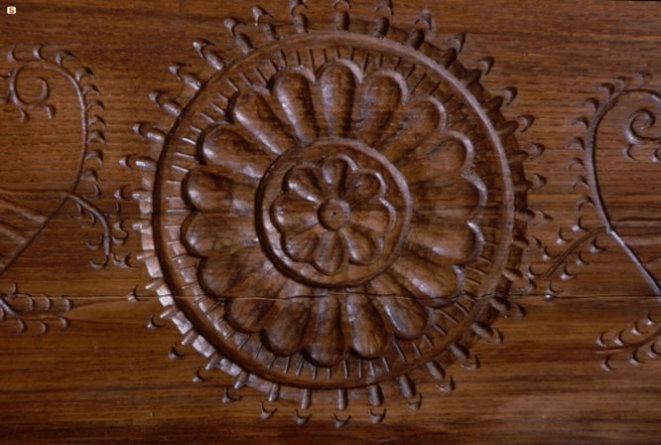Made in Sardinia
Top quality craftsmanship
One of the most widespread activities in Sardinia is craft that, in addition to transmit the ancient traditions and so to preserve the historical and human heritage, represents the most original and interesting expression of Sardinian art.
Weaving, pottery, the manufacturing of metals, carving and the art of weaving are still made through no modern techniques and methods; therefore, it allows to obtain things from those more useful to those decorative, with a considerable artistic taste. The patterns of decorations, the stylised shapes and colors often recall an ancient past: it is enough to visit an archaeological museum for find again the inspiration of the figures painted on the carpets or the geometric patterns of potteries or the etchings on the bone handle of knives.

The beautiful chests made through the wood of the carved chestnut, often present flower patterns on the frame that surround a central motif: birds with long curl beaks and plumed tails face each other. The production of things that are carved on the wood is spread above all in Barbagia and Mandrolisai.
The craft of weaving, through its baskets and "corbule" with various shapes and sizes, is characterized by the materials used and the areas which they come from: for instance, in Castelsardo, Sennori and Sorso artisans weave reed and raphia; the same is in the territory of Nuoro. In some villages of Barbagia asphodel is the raw material, decorated through an essential simplicity. In Sinnai, in the territory of Cagliari, where for many years there is a market exhibition of weaved things, they use reed with the brocade central decoration with intense and various colors. Instead, in the territory of Oristano artisans work the swamp plants obtaining wickers and baskets.
Terracotta is produced for the most ancient eras and today artisans create things with an unique style and elegant and polished things keeping shapes and decorations inspired to nature and to prehistoric geometries. Assemini, Dorgali, Oristano, Pabillonis and Nuoro are the centers of greater production, where there is sometimes the use of the same techniques of making of clay, long and hard, of the ancient Sardinian populations, so obtaining some perfect duplicates of utensils, jugs, amulets and pintaderas discovered during the excavations in the archaeological areas.
It is appropriate to remember also the production of beautiful clasp knives, in Sardinian language "arresoja" or "leppa" (otherwise "pattadese" from the area of production, namely Pattada, in the province of Sassari), with horn handles and very sharp steel blades; finally, the making of cork in Gallura, from which you can obtain stoppers, decorative papers and even clothes.

A special mention is deserved to the art of weaving and jewellery. The most used technique of goldsmithing is certainly filigree that consists in the manufacturing by weaving of thin precious metal threads that, after twisting, are fixed on a pillar with the same metal, in order to create an elegant effect with a pierced structure.
Thanks to the big amount of wool produced in the Island, the textile craft is noteworthly: in ancient times, it was a kind of domestic craft and an exclusive feminine activity. The competence in the weaving through loom took part of that skills baggage socially requested to women, that was different according to their social origin.
Fabrics for ceremony, those that were the most elaborate and with a more refined quality, were a prerogative of the most well-off classes. A characterisation of the decorative patterns and of the chromatic choices allows an immediate identification of the area of origin of fabrics. Among the embroideries, above all destined to complete clothes and domestic dowry, it stands out the filet of Bosa, the Làuru ‘osincu.
Embroidered by needle, on a net realized by spool whose bows are the same compared to those of the fishing nets, it was the first kind of Sardinian craft that became well-known internationally.
In the last decades, there has been a good recovery of the craft industry and the level and the taste of people’s creations has been elevated incredibly. The products of this craft, that re-elaborates the patterns and the models of ancient tradition, are requested and appreciated and they are showed to the admiration of the most demanding consumers.